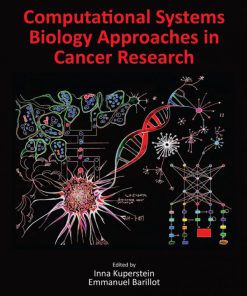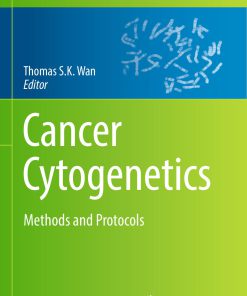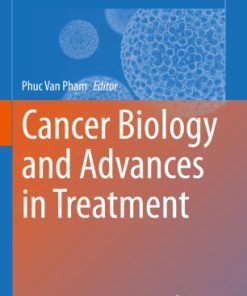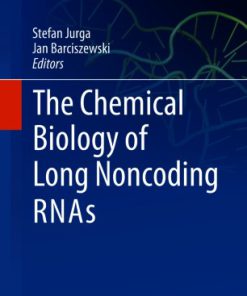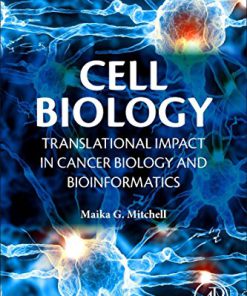The Long and Short Non coding RNAs in Cancer Biology 1st Edition by Erwei Song ISBN 9811014981 9789811014987
$50.00 Original price was: $50.00.$25.00Current price is: $25.00.
The Long and Short Non coding RNAs in Cancer Biology 1st Edition by Erwei Song – Ebook PDF Instant Download/Delivery: 9811014981, 9789811014987
Full download The Long and Short Non coding RNAs in Cancer Biology 1st Edition after payment

Product details:
ISBN 10: 9811014981
ISBN 13: 9789811014987
Author: Erwei Song
The book conveys a comprehensive knowledge of long and short ncRNAs in cancer regulation and their potentials as diagnostic biomarkers and therapeutic targets. Topics covered include the molecular mechanisms of various classes of ncRNAs (with emphasis on long non-coding RNAs and microRNAs) in cancer, the functional roles of ncRNAs in regulating different cancer hallmarks (including proliferation, apoptosis, stem-cell properties, epithelial-mesenchymal transition, metabolism, angiogenesis, tumor-host interactions and therapeutic resistance), the role of ncRNAs in regulating cancer signaling circuitry programs (highlighting their involvement in c-myc, p53 and NFkB signaling), a systemic summary of clinical and preclinical studies that evaluate the potential of ncRNA signatures for cancer diagnosis and prognosis and strategies to delivery short ncRNAs as therapeutic molecules for cancer treatment. This book may serve as a comprehensive resource for researchers, graduate students and oncologists in ncRNA and cancer research and help drug development by identifying ncRNA targets.
The Long and Short Non coding RNAs in Cancer Biology 1st Table of contents:
Chapter 1: Noncoding RNAs: New Players in Cancers
1.1 Introduction
1.2 The Landscape of MicroRNAs
1.2.1 MicroRNA Biogenesis and Functional Mechanism
1.2.2 Deregulation of miRNA Biogenesis in Cancers
1.2.3 Biological Roles of miRNAs in Cancers
1.2.3.1 Sustaining Proliferative Signaling
1.2.3.2 Evading Growth Suppressors
1.2.3.3 Resisting Cell Death
1.2.3.4 Enabling Replicative Immortality
1.2.3.5 Inducing Angiogenesis
1.2.3.6 Activating Invasion and Metastasis
1.2.3.7 Genome Instability and Mutation
1.2.3.8 Tumor-Promoting Inflammation
1.2.3.9 Reprogramming Energy Metabolism
1.2.3.10 Evading Immune Destruction
1.2.4 Clinical Application of miRNAs in Cancers
1.2.4.1 Diagnostics
1.2.4.2 Therapeutics
1.3 The Landscape of Long NcRNAs
1.3.1 Biogenesis and Classification of LncRNAs
1.3.2 Molecular Mechanisms of LncRNAs in Cancers
1.3.3 Functional Mechanisms of LncRNAs in Cancers
1.3.3.1 Epigenetic Regulation: in Cis and in Trans
1.3.3.2 Transcriptional Regulation
1.3.3.3 Posttranscriptional Regulation
1.3.3.4 Other Roles of LncRNAs in Cancers
1.3.4 Biological Roles of LncRNAs in Cancers
1.3.5 Diagnostic and Therapeutic Application of LncRNAs in Cancers
1.4 The Landscape of Circular RNAs
1.4.1 Formation and Classification
1.4.2 Properties of CircRNAs
1.4.3 Functions and Mechanisms of CircRNAs in Cancers
1.5 Other NcRNAs Implicated in Cancers
1.6 Concluding Remarks and Future Perspectives
References
Chapter 2: The Working Modules of Long Noncoding RNAs in Cancer Cells
2.1 Introduction
2.2 Epigenetic Regulation
2.2.1 lncRNAs Involved in Histone Modification
2.2.2 lncRNAs Involved in DNA Methylation
2.2.3 Correlation Between the Sense and Antisense Transcripts
2.3 RNA Transcription
2.3.1 Role of NcRNAs in Controlling Initiation and Elongation of Transcription
2.3.2 lncRNAs Regulate Transcription of Specific Genes
2.3.3 lncRNAs Join P53 Network by Regulating Transcription
2.3.4 Circular Intronic RNA (ciRNA)
2.4 Posttranscriptional RNA Processing
2.4.1 Alternative Splicing
2.4.1.1 MALAT1
2.4.1.2 sno-lncRNAs
2.4.2 lncRNAs Function as miRNA Sponges
2.5 Protein Translation
2.6 Posttranslational Protein Modification
2.7 Summary and Perspectives
References
Chapter 3: Methods to Study Long Noncoding RNA Biology in Cancer
3.1 Introduction
3.2 Screening for Functional lncRNAs
3.2.1 Microarray and RNA Sequencing
3.2.2 Screening of lncRNAs Based on RNA–Protein Interaction
3.2.2.1 RIP-Chip and RIP-Seq
3.2.2.2 CLIP-Seq
3.3 Identifying lncRNAs
3.3.1 Cloning the Full-Length Sequence of lncRNA
3.3.2 Predicting the Coding Potential of lncRNA
3.3.3 Ribosome Enrichment Assay
3.3.4 Subcellular Location of lncRNAs
3.3.4.1 Fractionation qPCR
3.3.4.2 FISH
3.4 Detecting lncRNA Expression
3.4.1 Northern Blot
3.4.2 qRT-PCR
3.4.3 ISH and FISH
3.5 Manipulating lncRNA Expression
3.5.1 Loss of Function
3.5.1.1 siRNA and shRNA
3.5.1.2 Antisense Oligonucleotides (ASOs)
3.5.1.3 CRISPR/Cas-Based Methods
3.5.2 Gain of Function
3.6 Mapping lncRNA Binding Sites on the Genome
3.6.1 Chromatin Isolation by RNA Purification (ChIRP)-Seq
3.6.2 Capture Hybridization Analysis of RNA Targets (CHART)-Seq
3.6.3 RNA Antisense Purification (RAP)-Seq
3.7 Discovering RNA–Protein Interactions
3.7.1 Identifying the lncRNA-Bound Proteome
3.7.2 Validating the RNA–Protein Interaction
3.7.2.1 RNA Immunoprecipitation (RIP)
3.7.2.2 RNA Pulldown
3.7.2.3 RNA-EMSA
3.7.2.4 In Situ Visualization of RNA and Proteins
3.8 Probing and Analyzing lncRNA Structure
3.8.1 Bioinformatics to Predict RNA Structure: Mfold, RNAfold, and RNA Structure
3.8.2 RNA Secondary Structure Probing and RNA Footprinting
3.8.3 RNA-Selective 2′-Hydroxyl Acylation and Primer Extension (SHAPE)
3.8.4 Parallel Analysis of RNA Structure (PARS)
3.9 Identifying RNA–Protein Interfaces
3.9.1 RNA Mechanically Induced Trapping of Molecular Interactions (RNA-MITOMI)
3.9.2 Domain-Specific ChIRP (dChIRP)
3.9.3 RNase Protection Assay
3.9.4 Structural Analysis of Protein–RNA Interactions with Biotin-Labeling Assay and Mass Spect
3.10 Detecting Regulation of lncRNA Expression
3.10.1 Methylation-Specific PCR (MSP) and Bisulfate Sequencing PCR (BSP)
3.10.2 Chromatin Immunoprecipitation (ChIP)
3.10.3 Reporter Assay
3.10.4 DNA Electrophoretic Mobility Shift Assay (DNA-EMSA)
3.11 Animal Models of lncRNA
3.11.1 Genetically Engineered Mouse (GEM) Models
3.11.1.1 Transgenic Mouse Model
3.11.1.2 Knockout Mouse Model
3.11.2 Tumor Xenografts
3.12 Conclusion
References
Chapter 4: Relationship Between Noncoding RNA Dysregulation and Epigenetic Mechanisms in Cancer
4.1 Introduction
4.2 Identification of Epigenetically Dysregulated miRNAs
4.3 miRNA Dysregulation via DNA Methylation
4.3.1 miR-124 Family
4.3.2 miR-34 Family
4.3.3 miR-9 Family
4.3.4 miR-200 Family and miR-205
4.3.5 miR-137
4.3.6 miR-145
4.3.7 miR-129-2
4.3.8 Hypomethylation of miRNA Genes
4.3.9 Clinical Implications of DNA Methylation
4.4 miRNA Dysregulation Due to Histone Modification
4.5 Epigenetic Alterations Induced by miRNAs
4.5.1 DNA Methylation
4.5.2 Histone Modifications
4.6 Epigenetic Dysregulation of lncRNA Genes
4.7 Epigenetic Alterations Induced by lncRNAs
4.8 Concluding Remarks
References
Chapter 5: Noncoding RNAs in Growth and Death of Cancer Cells
5.1 Introduction
5.2 miRNA in Growth and Death of Cancer Cells
5.2.1 Proliferation
5.2.2 Cell Cycle
5.2.3 Apoptosis
5.2.4 Necrosis
5.2.5 Autophagy
5.3 lncRNA in Growth and Death of Cancer Cells
5.3.1 Proliferation
5.3.2 Cell Cycle
5.3.3 Apoptosis
5.3.4 Necrosis
5.3.5 Autophagy
5.4 Other ncRNAs in Growth and Death of Cancer Cells
5.4.1 Proliferation
5.4.1.1 rRNA
5.4.1.2 tRNA
5.4.1.3 snoRNA
5.4.1.4 circRNA
5.4.1.5 piRNA
5.4.2 Cell Cycle
5.4.2.1 siRNA
5.4.2.2 piRNA
5.4.3 Apoptosis
5.4.3.1 snRNA
5.4.3.2 snoRNA
5.4.3.3 piRNA
5.4.4 Necrosis
5.4.5 Autophagy
5.4.5.1 rRNA
5.5 Conclusion
References
Chapter 6: Noncoding RNAs in Cancer Cell Plasticity
6.1 Introduction
6.2 Cancer Cell Plasticity, Tumor Progression, and Cancer Stem Cell Biology
6.3 MicroRNAs Regulate Cancer Cell Plasticity and Tumor Progression
6.4 MicroRNAs Play Important Roles in Regulating Cancer Stem Cells
6.5 Long Noncoding RNAs (LncRNAs) in Cancer Biology and Regulating Cancer Cell Plasticity
6.6 Conclusions and Perspectives
References
Chapter 7: Noncoding RNAs in Regulation of Cancer Metabolic Reprogramming
7.1 Introduction
7.1.1 Metabolic Reprogramming in Cancer
7.1.2 Noncoding RNAs in Cancer
7.1.3 The Interplay Between Noncoding RNAs and Cancer Metabolism
7.2 MicroRNAs Regulate Cancer Metabolic Reprogramming
7.2.1 MiRNAs and Glucose Metabolism
7.2.1.1 Source of Glucose
7.2.1.2 Consumption of Glucose
7.2.1.3 Glucose-Related Signaling Pathways
7.2.2 MiRNAs and Lipid Metabolism
7.2.2.1 Fatty Acid Metabolism
7.2.2.2 Cholesterol Metabolism
7.2.2.3 SREBPs, LXR, PPARα, and Signal Transduction Pathways
7.2.3 MiRNAs and Amino Acid Metabolism
7.2.3.1 Glutamine and Proline
7.2.3.2 One-Carbon Metabolism
7.2.3.3 Branched-Chain Amino Acids
7.3 Long Noncoding RNAs Regulate Cancer Metabolism Reprogramming
7.4 Other Noncoding RNAs in Cancer Metabolism Reprogramming
7.4.1 PIWI-interacting RNAs
7.4.2 Small Nucleolar RNAs
7.4.3 Circular RNAs
7.5 Conclusions and Future Perspectives
References
Chapter 8: Noncoding RNAs in Tumor Angiogenesis
8.1 Introduction
8.2 Tumor Angiogenesis
8.3 Importance of MicroRNAs in Regulation of Tumor Angiogenesis
8.3.1 Important miRNAs in Angiogenesis
8.3.1.1 MicroRNA-17 Gene Family
8.3.1.2 MiR-378
8.3.1.3 MiR-98
8.3.1.4 MiR-126
8.3.1.5 MiR-221 and MiR-222
8.3.1.6 MiR-15b and MiR-16
8.3.1.7 MiR-130a
8.3.1.8 MiR-210
8.3.1.9 Let-7 Family
8.3.1.10 MiR-296
8.3.2 Other miRNAs Related to Angiogenesis
8.3.3 Tumor-Specific MicroRNAs
8.3.3.1 In Colorectal Cancer Cells
8.3.3.2 In Glioblastoma Cells
8.3.3.3 In Human Gastric Cells
8.3.3.4 In Prostatic Cancer Cells
8.3.4 Conclusion
8.4 Role of Long Noncoding RNAs in Regulation of Tumor Angiogenesis
8.4.1 Long Noncoding RNA MALAT1
8.4.2 Long Noncoding RNA MVIH
8.4.3 The Long Noncoding RNA HOXD-AS1
8.4.4 The Long Noncoding RNA HIF-1A-AS2
8.4.5 The Long Noncoding RNA MEG3
8.4.6 Other Long Noncoding RNAs
8.5 Interactions Between MicroRNAs and Long Noncoding RNAs
8.5.1 MicroRNA Interactions with LncRNA MALAT1
8.5.2 MicroRNA Let-7 Interactions with LncRNA
8.5.3 MicroRNA Interactions with LncRNA-RoR
8.6 Conclusion
References
Chapter 9: Noncoding RNAs in Cancer Immunology
9.1 Introduction
9.1.1 History of Cancer Immunology
9.1.2 Current Understanding of Cancer Immunology
9.1.2.1 Elimination Phase
9.1.2.2 Equilibrium Phase
9.1.2.3 Escape Phase
9.1.3 Noncoding RNA
9.2 MicroRNAs and Cancer Immunology
9.2.1 MicroRNAs and Macrophage
9.2.1.1 miR-17-5p, miR-20a, and miR-106a
9.2.1.2 miR-155
9.2.1.3 Other miRNAs
9.2.2 MicroRNA and NK Cells
9.2.3 MicroRNA and T Cells
9.2.3.1 miR-146a and miR-146b
9.2.3.2 miR-155
9.2.3.3 miR-181a
9.2.3.4 miR-17-92
9.2.3.5 Other miRNAs
9.2.4 MicroRNA and B cells
9.2.4.1 miR-181b
9.2.4.2 miR-150
9.2.4.3 miR-155
9.3 lncRNA and Cancer Immunology
9.3.1 lincRNA-cox2
9.3.2 PACER
9.3.3 NKILA
9.3.4 lnc-DC
9.3.5 THRIL
9.3.6 lnc-IL7R
9.3.7 Lethe
9.3.8 IFNG-AS1
9.3.9 lincR-Ccr2-5′AS
9.3.10 GATA3-AS1
9.3.11 Th2-LCR
9.3.12 linc-MAF-4
9.3.13 NRON
9.3.14 Fas-AS1
9.4 Outlook
References
Chapter 10: Noncoding RNAs in Therapeutic Resistance of Cancer
10.1 Introduction
10.2 Conventional and Targeted Therapy of Cancer
10.2.1 Chemo- and Radiotherapy
10.2.2 Molecular Targeted Therapy
10.2.3 Gene, Cell, and Immune Therapy
10.3 General Mechanisms of Resistance to Cancer Therapeutics
10.4 Counteracting Roles of Therapy-Evoked and ncRNA-Related Signaling Events in Cancer Cells
10.4.1 Canonical Intracellular Pathways for Cell Survival and Division
10.4.2 Oncogenic Ligands and Receptors
10.4.2.1 Growth Factors/Receptors
10.4.2.2 Ontogenesis-Related Ligands/Receptors
10.4.2.3 Steroid Hormone and Receptors
10.4.3 Key Transcriptional Factors
10.4.4 Cell Cycle Progression
10.4.5 Apoptotic Machinery
10.4.6 Genotoxic Stress
10.4.7 Oxidative Stress
10.4.8 Malignant Phenotypes: Cancer Stem Cells (CSCs), Autophagy, and Epithelial–Mesenchymal Tran
10.5 Drug Accessibility Regulated by ncRNA in Cancer Treatment
10.5.1 Drug Export
10.5.1.1 ATP-Binding Cassette (ABC) Transporters
ABCB1
ABCCs
ABCG2
10.5.1.2 Nucleoside Transporter (NT) Proteins
10.5.2 Blockade of Drug–Target Interactions
10.6 Drug Pharmacokinetics Controlled by ncRNAs
10.7 Drug-Refractory Cancer Microenvironment Modulated by Noncoding RNAs
10.8 Complicated Solo Performance: Combined Versus Unknown Targets
10.9 Strategies for Overcoming ncRNA-Mediated Therapeutic Resistance
10.10 Future Perspectives
References
Chapter 11: Noncoding RNAs Regulating Cancer Signaling Network
11.1 Introduction
11.2 Receptor Tyrosine Kinase Signaling
11.3 The Ras/Raf/MEK/ERK Signaling Pathway
11.4 The PI3K/AKT Signaling Pathway
11.5 The TGF-β Signaling Pathway
11.6 The Wnt/β-Catenin Signaling Pathway
11.7 The Notch Signaling Pathway
11.8 The Hedgehog Signaling Pathway
11.9 Other Signaling Pathways
11.10 MiRNAs in the Crosstalk Between Signaling Pathways
11.11 Conclusion
References
Chapter 12: Noncoding RNAs Regulating NF-κB Signaling
12.1 Introduction
12.2 Significance of NF-κB Signaling in Cancer Biology
12.2.1 NF-κB Signaling Links Inflammation and Cancer
12.2.2 NF-κB Signaling Promotes Cell Proliferation and Inhibits Cell Apoptosis
12.2.3 NF-κB Stimulates Tumor Cell Invasion and Metastasis
12.2.4 NF-κB Modulates Tumor Angiogenesis
12.2.5 NF-κB Is Involved in Cancer Metabolism
12.3 The Molecular Process of NF-κB Signaling: Mechanism and Regulation
12.4 Noncoding RNAs Involved in Regulation of NF-κB Signaling in Cancer
12.4.1 MicroRNAs (miRNAs) in NF-κB Signaling
12.4.1.1 MiR-30e* Inhibits NF-κB Inhibitor IκB
12.4.1.2 MiR-138 Suppresses NF-κB Activity by Inhibiting Ubiquitination of TRAF2 and RIP1
12.4.1.3 MiR-486 Suppresses SYLD, ITCH, and TNIPs
12.4.1.4 MiR-182 Links NF-κB with TGF-β Signaling
12.4.1.5 MiR-892b Inhibits NF-κB Signaling via Targeting TRAF2, TAKa, and TAB3
12.4.2 Long Noncoding RNAs (lncRNAs) in NF-κB Signaling
12.4.2.1 NF-κB Interacting lncRNA (NKILA)
12.4.2.2 P50-Associated COX-2 Extragenic RNA (PACER)
12.4.3 BRAF-Activated Noncoding RNA (BANCR)
12.4.4 Other Noncoding RNAs in Modulation of Cellular Signal Transduction and Potential Significa
12.5 Potential Therapeutic Implication and Limitation
References
Chapter 13: Noncoding RNAs Regulating p53 and c-Myc Signaling
13.1 Introduction
13.2 Noncoding RNAs Regulating p53 Signaling
13.2.1 Long Noncoding RNAs Regulating p53 Signaling
13.2.1.1 Long Noncoding RNAs as Effectors of p53 Signaling
LincRNA-p21
PANDA
Loc285194
TUG1
p53-Related eRNAs
13.2.1.2 Long Noncoding RNAs as Regulators of p53 Signaling
MALAT1
MEG3
Wrap53
ROR
13.2.2 MiRNAs Regulating p53 Signaling
13.2.2.1 MiRNAs as Effectors of p53 Signaling
13.2.2.2 MiRNAs as Regulators of p53 Signaling
13.2.2.3 Feedback Loops Involved in MiRNA-Regulated p53 Signaling
13.3 Noncoding RNAs Regulating c-Myc Signaling
13.3.1 Long Noncoding RNAs Regulating c-Myc Signaling
13.3.1.1 Long Noncoding RNAs as Effectors of c-Myc Signaling
H19
CCAT1
MINCR
BCYRN1
13.3.1.2 Long Noncoding RNAs as Regulators of c-Myc Signaling
CCAT1-L
GHET1
GAS5
PCAT-1
PVT1
PCGEM
13.3.2 MiRNAs Regulating c-Myc Signaling
13.3.2.1 MiRNAs as Effectors of c-Myc Signaling
13.3.2.2 MiRNAs as Regulators of c-Myc Signaling
13.4 Conclusions
References
Chapter 14: Viral Noncoding RNAs in Cancer Biology
14.1 Introduction
14.2 Virally Transcribed Long Noncoding RNAs
14.2.1 EBV-Encoded RNAs (EBERs)
14.2.2 Herpesvirus Saimiri U-Rich RNAs (HSURs)
14.2.3 LncRNA β2.7
14.2.4 KSHV-Encoded Polyadenylated Nuclear RNA (PAN RNA)
14.2.5 Noncoding Sub-genomic Flavivirus RNA (sfRNA)
14.2.6 Intronic Long Noncoding RNAs
14.3 Virus-Encoded MicroRNAs
14.3.1 EBV-Encoded miRNA
14.3.2 KSHV-Encoded MiRNA
14.3.3 HPV-Encoded MicroRNA
14.3.4 MCV-Encoded MicroRNA
14.4 Future Perspective
References
Chapter 15: Noncoding RNAs in Cancer Diagnosis
15.1 Introduction
15.2 Types of ncRNAs and Cancer Diagnosis
15.2.1 Small RNAs
15.2.1.1 snoRNAs and Cancer Diagnosis
15.2.1.2 piwiRNAs and Cancer Diagnosis
15.2.1.3 miRNAs and Cancer Diagnosis
15.2.2 lncRNAs
15.2.2.1 Intergenic lncRNAs and Cancer Diagnosis
15.2.2.2 Antisense lncRNAs and Cancer Diagnosis
15.2.2.3 Sense lncRNAs and Cancer Diagnosis
15.3 Noncoding RNAs and Major Cancer Types
15.3.1 microRNAs Acting as Diagnostic Cancer Biomarker
15.3.1.1 microRNAs and Colorectal Cancer
15.3.1.2 microRNAs and Prostate Cancer
15.3.1.3 microRNAs and Hepatocellular Carcinoma (HCC)
15.3.2 lncRNAs Acting as Diagnostic Cancer Biomarker
15.3.2.1 lncRNAs and Prostate Cancer
15.3.2.2 lncRNAs and the Esophagus
15.3.2.3 lncRNAs and Hepatocellular Carcinoma
15.3.2.4 lncRNAs and Nasopharyngeal Carcinoma
15.4 Circulating ncRNAs in Cancer
15.4.1 Circulating miRNAs as Cancer Biomarkers
15.4.1.1 Lung Cancer
15.4.1.2 Breast Cancer
15.4.1.3 Liver Cancer
15.4.1.4 Gastric Cancer
15.4.1.5 Colorectal Cancer
15.4.1.6 Hematologic Cancer
15.4.2 Circulating Piwi-Interacting RNAs as Cancer Biomarkers
15.4.3 Circulating snoRNAs in Cancer
15.4.4 Circulating Circular RNAs
15.4.5 Exosomal ncRNAs
15.4.5.1 Exosome miRNAs as Biomarkers of Cancer Diagnosis
15.4.5.2 Methods of Detecting Exosome-Based Noncoding RNA
15.4.5.3 Challenges with Exosomes for Diagnosis
15.4.5.4 The Future of Exosome-Mediated Diagnosis
15.5 ncRNAs in Non-blood Body Fluids
15.5.1 ncRNAs in Saliva
15.5.2 Urinary ncRNAs as Biomarkers in Urologic Cancers
15.5.2.1 PCa
15.5.2.2 BCa
15.5.2.3 RCC
15.5.3 ncRNAs in Feces
15.5.3.1 The Novel Biomarkers in Colorectal Cancer
15.5.3.2 The Noninvasive Biomarkers of Pancreatic Cancer
References
Chapter 16: Therapeutic Potentials of Noncoding RNAs: Targeted Delivery of ncRNAs in Cancer Cells
16.1 Introduction
16.2 Preclinical and Clinical Development of ncRNA-Based Therapeutics
16.2.1 Preclinical Development of ncRNA-Based Therapeutics
16.2.2 Clinical Development of ncRNA-Based Therapeutics
16.3 Conjugate Delivery Systems
16.3.1 Lipophile Conjugates
16.3.2 Peptide Conjugates
16.3.3 Antibody Conjugates
16.3.4 Aptamer Conjugates
16.4 Lipid-Based Delivery Systems
16.4.1 Cationic Liposomes
16.4.2 Neutral Liposomes
16.4.3 Stable Nucleic Acid Lipid Particles (SNALPs)
16.5 Polymer-Based Delivery Systems
16.5.1 Cyclodextrin
16.5.2 Polyethylenimine (PEI)
16.5.3 Poly(lactide-co-glycolide) (PLGA)
16.5.4 Dendrimers
16.6 Summary
People also search for The Long and Short Non coding RNAs in Cancer Biology 1st:
the long and short non coding rnas in cancer biology
the long noncoding rna xist
long noncoding rnas in cancer pathways
noncoding rna and cancer
long non coding rna quizlet
Tags:
Erwei Song,RNAs,Cancer Biology
You may also like…
Medicine
Computational Systems Biology Approaches in Cancer Research 1st Edition Inna Kuperstein (Editor)
Science (General)
Biology and other natural sciences
Cell biology : translational impact in cancer biology and bioinformatics 1st Edition Mitchell
Medicine - Natural Medicine
Cancer and the New Biology of Water 1st edition by Thomas Cowan ISBN 1603588825 9781603588829
Business & Economics - Investing
Biology and other natural sciences




